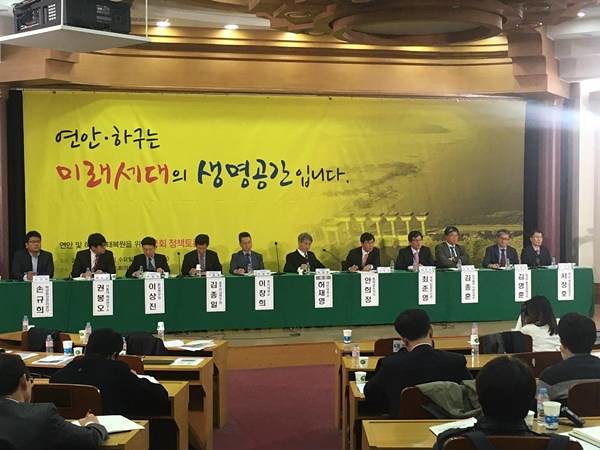Park Hyemi, Eco TV
16 November 2016
Translated by the EAAFP Secretariat

“The National Assembly Policy Debate for the Restoration of Coastal and Estuarine Ecosystem”, co-hosted by the offices of Park Wanju, Kim Taenyon, Kim Taehym, Seong Il-joing and organized by Chungcheng Nam-province, was held in the Members’ Office Building at the National Assembly in Seoul, Tuesday, Jan 16, 2017. © Eco TV Database
Half of Korean estuaries have been blocked by seawalls, dams and harbor and reclamation developments, a report said. Continuous disconnection of the flow of an estuary can lead to irreversible and devastating implications for ecological services. Therefore restoration is an urgent priority.
Mr. Lee Sang-Jin, the Head of the Research Office of Chung-nam National Institute, stated at the Policy Debate of the National Assembly on January 16, 2017. that 228 estuaries out of 463 are disconnected from seawater, accounting for almost half (49.2 %) of all estuaries
Notably, the Geum River has the highest number of estuaries closed – 61 (91%) out of 67, followed by Yeongsan River (80.7%), Seomjin River (53.5%), Han River (49.3%) and Nakdong River(28.7%).
Estuaries provide brackish water and various habitat provisioning ecosystem services and are recognized for their high ecological value. Each estuary has a distinctive set of features that have been produced by various factors such as tidal range, the volume of stream water, geographical conditions and types of surrounding areas.
Especially, estuaries provide numerous services. They purify polluted water, mitigate risks of flood and tsunami, and forestall erosion by building up sediments on the coastlines. In addition, they have economic, recreational and aesthetic values.
However, destructive developments such as Four Major River Project resulted in dysfunctional estuaries that no longer clean contaminated water. This led to catastrophic loss of the value of water resources.
In the Republic of Korea, seawalls have been built in 1,611 areas, and 17 mudflats of estuaries have been reclaimed. Still, many small and large wetlands are still being reclaimed now. Besides, as abandoned salt plants can often be found near mudflat areas, their loss can reduce biological diversity, so estuary restoration is urgent.

“The National Assembly Policy Debate for the Restoration of Coastal and Estuarine Ecosystem”, co-hosted by the offices of Park Wanju, Kim Taenyon, Kim Taehym, Seong Il-joing and organized by Chungcheng Nam-province, was held in the Members’ Office Building at the National Assembly in Seoul, Tuesday, 16 Jan 2017. © Eco TV Database
The purpose of building seawalls and dams was to prevent damage from floods and tsunamis and to secure water for agricultural, industrial and domestic use. There was a comment that reclamation helps alleviate food shortage to some extent. Nevertheless, developed countries are pushing forward with removing dams and bringing natural habitats back due to damage and loss of ecosystem services.
For instance as a seawall in Anmyeon, Chungcheongnam-do was reconstructed to a bridge, the flow of stream water was restored and became connected to the open sea. As a result, the number of manila clams has increased.
On the other hand, the east coast of South Korea recently experienced more erosion, blamed on reckless construction of seawalls.
Mr. Lee argued that these issues can be solved by letting sea water inside of the dams. This will enhance the water quality and restore the ecosystem in the end. Improving ecological environment can help increase local community income that can lead to sustainable estuary management and wetland creation, said Mr. Lee.
“Seomjin River is known as ‘a poor river’ because only 5 to 10 percent of river water flows down to the sea.” said Kim Jong-il, a researcher of Jeonnam National Institute based in Gwang-ju.
“Suncheon Bay has been designated as a national protected area and Ramsar site because it has been well conserved and managed. Eventually, it became a successful case of a Korean Ecological City,” he stressed.
Mr. Lee said “studying and finding appropriate and applicable models for each estuary is the key.” “Chungcheongnam-do’s core project of the current administration is estuarine restoration so that they are conducting studies and checking feasibility and validity of potential projects.”
Professor Lee Chang-Hee from the Myeong-ji University presented the need to develop legislation for estuarine management and added that forming a joint policy consultation committee between the Ministry of Environment and Ministry of Oceans and Fisheries may be necessary to avoid work duplication. After formation, steps for developing a national estuarine policy should be established and implemented, he stressed.
“The jurisdiction of estuarine management is under different local governments. Therefore, the best way to develop the legislation is through members of National and/or Local Assemblies. This should be included to the pledge list for the presidential election next year,” he emphasized.
Governor Ahn Hee-Jung of the Chung Nam Province, other members of assemblies and technical advisors participated to this debate, which was co-hosted by the Offices of Congressman Park Wanju, Congressman Kim Taenyon, Congressman Kim Taehym and Congressman Seong Il-joing, and organized by the Chung Cheong Nam Province.
Original article : http://www.greenpostkorea.co.kr/news/article.html?no=69609




